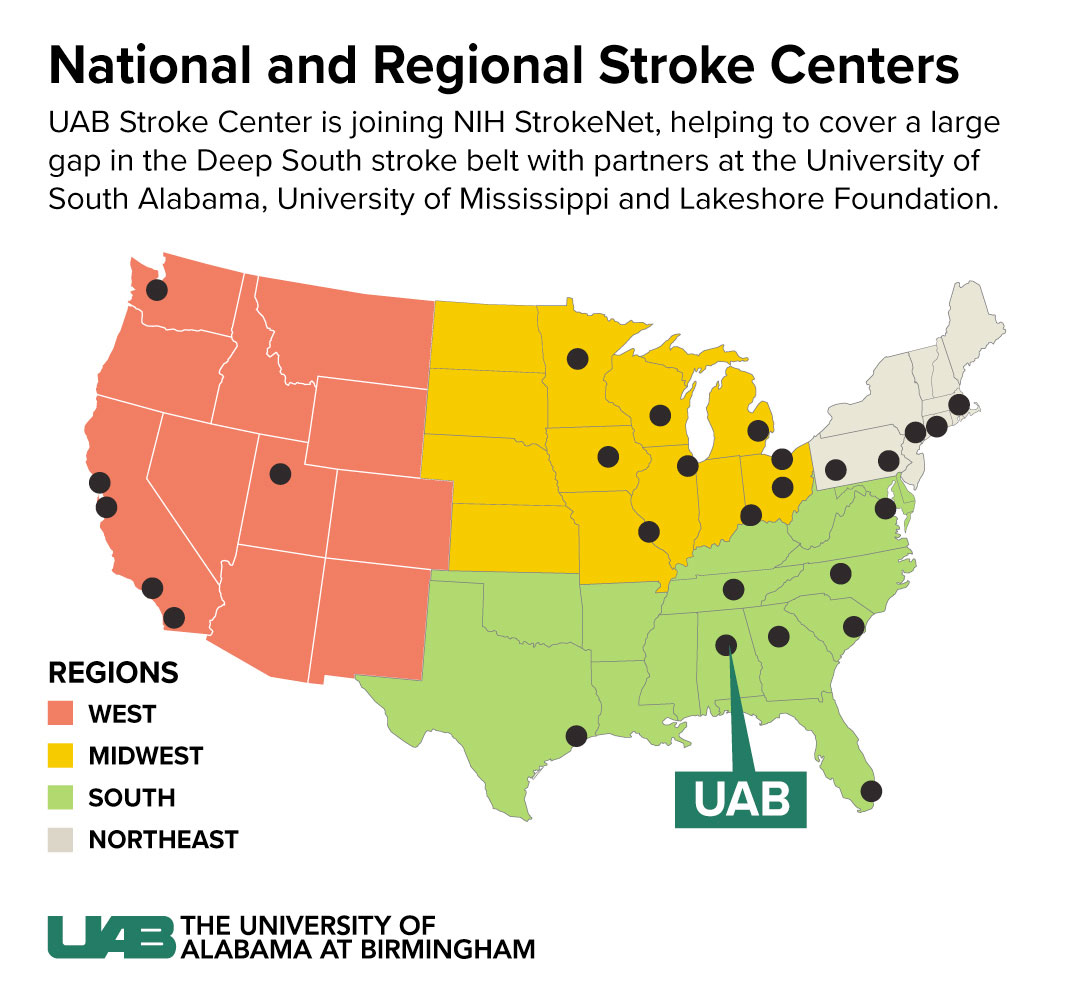 Toby Gropen, M.D.The University of Alabama at Birmingham will fill a large hole in the stroke belt as it leads a consortium of medical institutions from the Deep South in joining the National Institutes of Health StrokeNet under a grant of $1 million over five years from the National Institute of Neurological Disorders and Stroke.
Toby Gropen, M.D.The University of Alabama at Birmingham will fill a large hole in the stroke belt as it leads a consortium of medical institutions from the Deep South in joining the National Institutes of Health StrokeNet under a grant of $1 million over five years from the National Institute of Neurological Disorders and Stroke.
NIH StrokeNet is a network of 25 regional centers across the U.S., involving more than 200 hospitals, designed to serve as the infrastructure and pipeline for exciting new potential treatments for patients with stroke and those at risk for stroke.
“If you look at a map of the location of StrokeNet centers, you see a gap stretching from Alabama west into Mississippi and across the Mississippi River,” said Toby Gropen, M.D., James H. Halsey Jr., MD Endowed Professor and director of the Division of Cerebrovascular Disease in the UAB Department of Neurology, School of Medicine, and director of the Comprehensive Neurovascular and Stroke Center at UAB. “This area is part of what we refer to as the stroke belt, and our participation in StrokeNet could be transformative for this region.”
The University of Mississippi Medical Center in Jackson, the University of South Alabama and Lakeshore Foundation are partnering with UAB in StrokeNet. Along with Gropen, primary investigators on the project are Mark Harrigan, M.D., professor in the UAB Department of Neurosurgery and Ronald Lazar, Ph.D., Evelyn F. McKnight Endowed Chair in the Department of Neurology and director of the UAB Evelyn F. McKnight Brain Institute.
 The goal of StrokeNet is to conduct small and large clinical trials to advance acute stroke treatment, stroke prevention, recovery and rehabilitation following a stroke. In addition, StrokeNet provides an educational platform for stroke physicians and clinical trial coordinators.
The goal of StrokeNet is to conduct small and large clinical trials to advance acute stroke treatment, stroke prevention, recovery and rehabilitation following a stroke. In addition, StrokeNet provides an educational platform for stroke physicians and clinical trial coordinators.
“Given our location, UAB’s participation in StrokeNet will give greater access to research opportunities to underserved patients across the stroke belt,” said Harrigan. “Along with our regional partners, we will be able to better tie into stroke research across the nation, giving our ideas a national stage while simultaneously benefiting from the experiences of institutions in other regions of the country.”
A major focus of the UAB-led contingent will be recruitment of African-Americans to participate in clinical stroke research. Nearly 800,000 people experience a stroke each year, and African-Americans are more effected by stroke than other racial groups in the United States. African-Americans are twice as likely to die from a stroke as Caucasians. In general, minorities have higher stroke risks, stroke occurrence at an earlier age and more severe strokes.
“UAB has a unique opportunity to recruit and conduct clinical trials in stroke,” said Lazar. “And while StrokeNet focuses mostly on clinical research, there is a component of basic science research as well to develop biomarkers for treatment response and recovery, which fits nicely into UAB’s robust research infrastructure.”
The UAB investigators are encouraged by the progress made in stroke prevention and therapy. For example, there are recent studies that show how brain imaging can help physicians determine which patients are most likely to benefit from clot removal, which can speed up the process of administering clot-busting medications such as tPA.
There are also new medications called PCSK9 inhibitors that can dramatically lower cholesterol in patients who are resistant to statin therapy, which could have significant benefit in prevention of stroke or recurrent stroke in patients, especially with heart conditions.
“We have a high incidence of stroke in Alabama and the South, and it is incumbent on us to be leaders in clinical care, research and education of the next generation of medical professionals dedicated to stroke care,” Gropen said. “Becoming a part of StrokeNet is the next step for UAB to achieve those aims.”